Physical Address
304 North Cardinal St.
Dorchester Center, MA 02124
The term hallux rigidus describes a painful condition of the metatarsophalangeal (MTP) joint of the great toe characterized by restricted motion (mainly dorsiflexion) and proliferative periarticular bone formation. It was initially reported in 1887 by Davies-Colley, who described a plantar-flexed position of the proximal phalanx in relationship to the first metatarsal head and proposed the name hallux flexus . A few months later, Cotterill reported on the same condition but coined the term hallux rigidus . Other terms, such as hallux limitus, dorsal bunion, hallux dolorosus, hallux malleus, and hallux limitus, dorsal bunion, hallux dolorosus, hallux malleus, and metatarsus primus elevatusmetatarsus primus elevatus (MPE), have been advocated. The terms hallux rigidus and hallux limitus are used interchangeably, although, to some, hallux limitus is distinguished by a decrease in dorsiflexion, whereas hallux rigidus describes an absence of motion. DuVries in 1959 and Moberg observed that other than hallux valgus, hallux rigidus is the most common condition to affect the first MTP joint and may be even more disabling than hallux valgus because of the limitations on ambulation that occur in more severe cases.
Hallux rigidus likely represents a continuum of first MTP involvement from adolescence through adulthood. Hallux rigidus was previously divided into adolescent and adult type. Nilsonne hypothesized that hallux rigidus in the adolescent was a primary deformity, whereas in the adult, hallux rigidus was a secondary deformity resulting from the development of degenerative arthritis. However, Bingold and Collins suggested that the two entities were merely a continuum of the same degenerative process, and Coughlin and Shurnas found no evidence to support a requirement for a distinction or classification based on age. Gould et al stated that 1 in 40 patients older than 50 years develop hallux rigidus.
Although Gould and Nilsonne suggested that hallux rigidus typically is characterized by bilateral involvement, studies reporting results of surgery have emphasized mainly unilateral involvement. However, if follow-up is continued for a long enough period, 80% or more of patients can be expected to have bilateral symptoms.
Gould reported a higher male involvement in those older than 30 years with complaints of hallux rigidus, but in those undergoing surgical repair, most studies have reported an overwhelmingly higher incidence of female involvement.
Bonney and Macnab also noted that in those with onset in teenage years, there was a 50% incidence of a family history. Coughlin and Shurnas found in their series of patients with hallux rigidus that nearly 95% of patients with a positive family history of great toe problems had bilateral hallux rigidus and that nearly 80% of all patients with hallux rigidus had a positive family history.
Although initially hallux rigidus is characterized by pain, swelling, and MTP synovitis, restricted dorsiflexion is a classic finding. As the degenerative process proceeds, proliferation of bony osteophytes on the dorsal and dorsolateral aspect of the first metatarsal head develop, creating a prominent bony ledge against which the proximal phalanx abuts ( Fig. 27-1A ). A substantial amount of new bone occasionally forms along the medial border of the first MTP joint. Hallux valgus is uncommon with hallux rigidus.
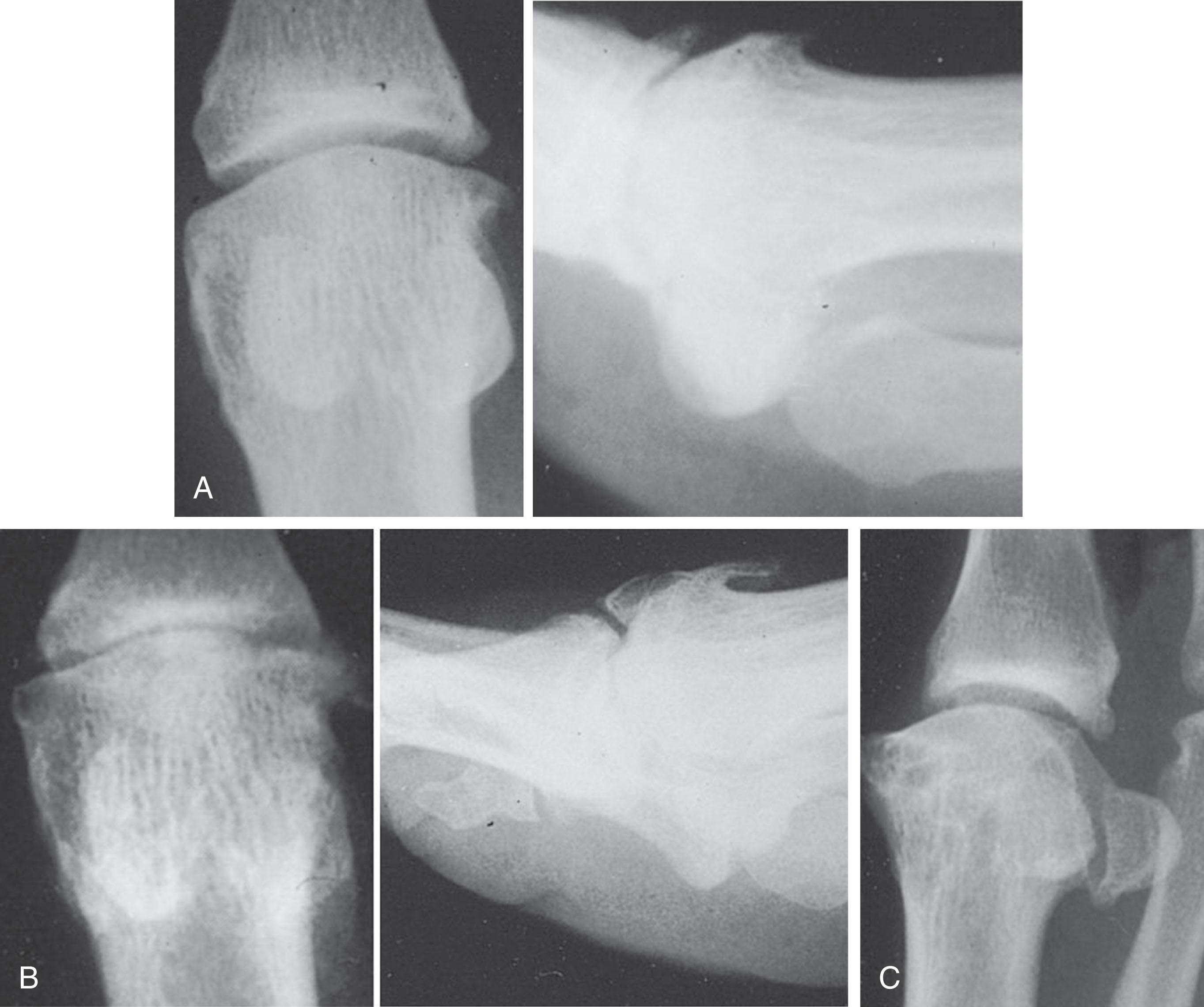
With time and further osteophyte formation, increased bulk around the MTP joint can lead to significant discomfort with constricting footwear ( Fig. 27-1B ). However, the joint space often remains reasonably well preserved despite the narrowed appearance on the AP view, as verified on the oblique radiograph ( Fig. 27-1C ). With enlargement of the dorsal exostosis of the first metatarsal head, the proximal phalanx can become positioned in plantar flexion with limitation of dorsiflexion, the condition for which the term hallux flexus was coined. With severe deformity, almost complete bony ankylosis can occur.
In adults with hallux rigidus, the basic pathologic entity is that of degenerative arthritis. Mann and Clanton noted that with increasing age increasing degenerative arthritis occurs. The classic location of the cartilage loss is on the dorsal half to two thirds of the metatarsal head, often at a site between the apex of the articular surface and the dorsal margin of the proximal phalanx.
The cause of hallux rigidus or hallux limitus has not been determined, although several predisposing factors have been cited. The most common cause cited is trauma, which can occur as either a single episode, such as an intraarticular fracture or crush injury, or with repetitive traumatic episodes. In a patient who sustains an acute injury to the MTP joint, forced hyperextension or forced plantar flexion can create compressive forces through jamming of the toe, with development of an acute chondral or osteochondral injury. What may begin as an acute sprain or turf toe can evolve into chronic discomfort.
An osseous injury can be diagnosed with radiographs ( Fig. 27-2 ). A clear traumatic episode is most likely the cause of unilateral hallux rigidus, based on long-term follow-up. In the adolescent patient with hallux rigidus, an osteochondral defect is often identified on radiographic examination or can be verified by MRI.

Other suggested causes of hallux rigidus include a congenital flattened or squared metatarsal head, a long first metatarsal, a short first metatarsal, tight intrinsic muscles, pes planus or hindfoot pronation, and a congruent MTP joint ( Fig. 27-3 ). Although investigators have hypothesized that these factors play a major role in the development of hallux rigidus, other than for osteochondritis, the only documented factors associated with the cause of hallux rigidus are a flat or chevron-shaped joint, hallux valgus interphalangeus, metatarsus adductus, bilaterality in those with a positive family history, trauma in unilateral cases, and female gender. There have been no proven associations with first-ray mobility, metatarsal length, Achilles or gastrocnemius contracture, any type of abnormal foot posture, hallux valgus, adolescent onset, footwear, occupation, or metatarsus primus elevatus.
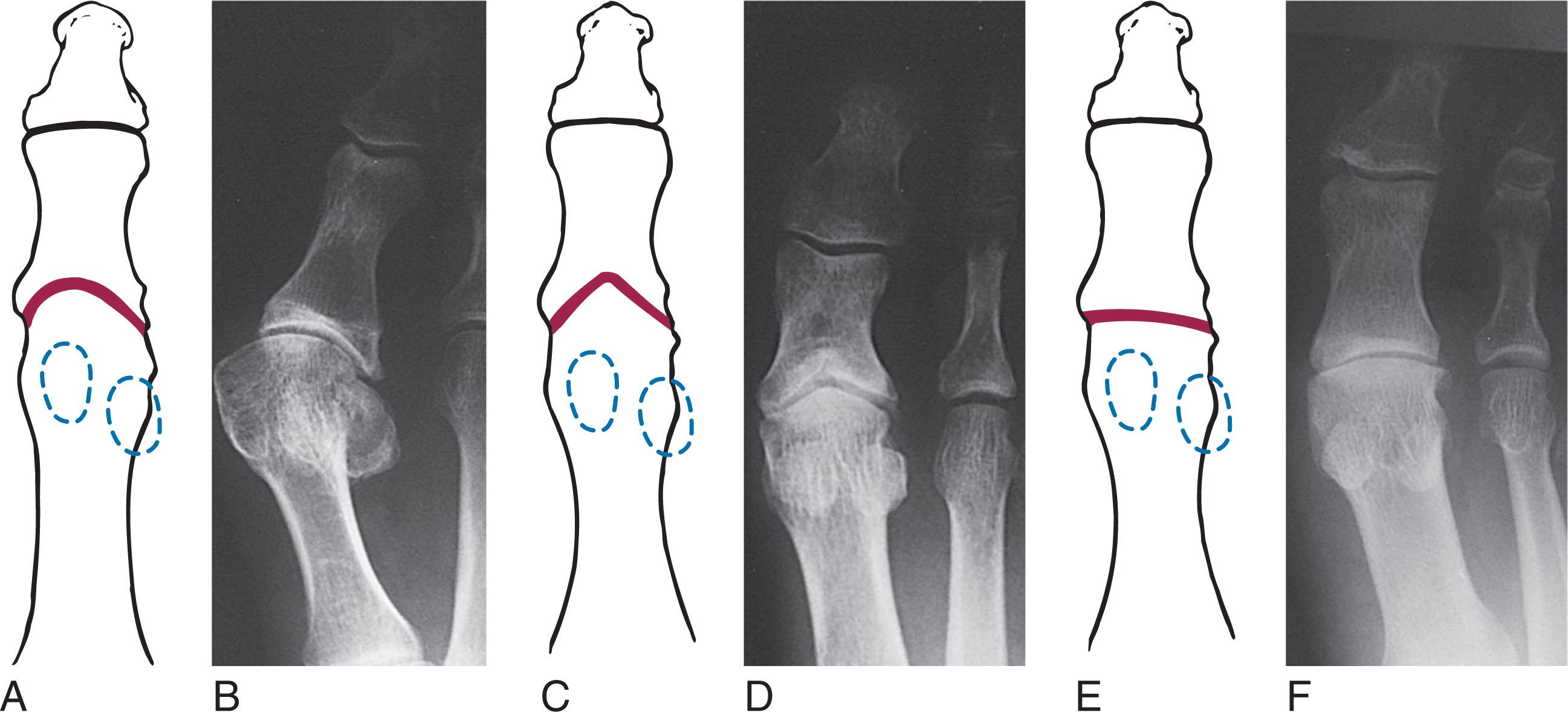
The length of the proximal phalanx and first metatarsal has been implicated in the etiology of hallux rigidus. Calvo et al measured a series of 132 feet with hallux rigidus and concluded the length of the proximal phalanx was not associated with hallux rigidus; however, they suggested a long first metatarsal was a factor in development of first MTP joint arthritis. Coughlin and Shurnas concluded a long first metatarsal (compared with the adjacent second metatarsal) was no more common in cases of hallux rigidus. Zgonis et al reported similar findings and concluded that excess length was not an etiologic factor in development of hallux rigidus.
One of the more controversial areas regarding etiology is the condition known as metatarsus primus elevatus ( Fig. 27-4 ), which describes a dorsal elevation of the first metatarsal in relationship to the lesser metatarsals. Although Lambrinudi in 1938 and Jack in 1940 initially called attention to hyperextension of the first ray, Root et al advanced a popularly accepted concept that hypermobility of the first ray “is the most frequent cause of hallux limitus.” Numerous other authors have supported the notion that an elevated first metatarsal is causally related to hallux rigidus or hallux limitus, but others dispute the relevance of this claim.
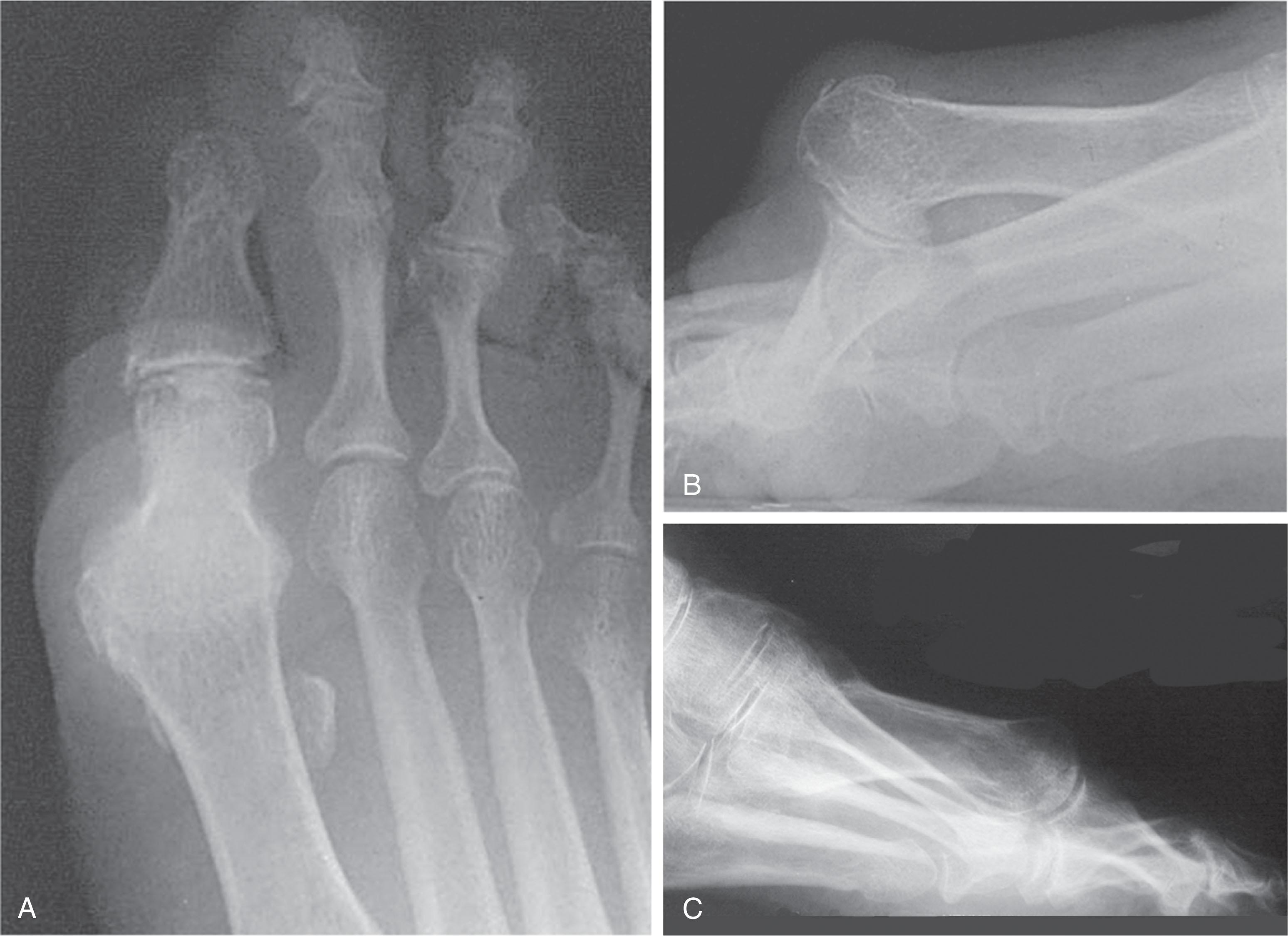
Bingold and Collins and others have distinguished between a structural (fixed) and a functional (flexible) elevation of the first metatarsal. Both conditions are believed to lead to restricted dorsiflexion of the first MTP joint, but with a flexible deformity, range of motion is decreased only with weight bearing. A fixed elevation of the first metatarsal is present whether the foot is weight bearing or not. Examples of a fixed metatarsus primus elevatus deformity are a dorsiflexed malunion of a first metatarsal osteotomy or fracture; a flexible elevation might occur with posterior tibial tendon insufficiency, muscle weakness, spasticity, or paralysis.
Elevation can occur anywhere along the axis of the first ray (metatarsal-cuneiform, cuneiform–navicular, or talonavicular joints). As the first metatarsal elevates, the hallux impacts or jams into the dorsal metatarsal articular surface, leading initially to limited or restricted dorsiflexion and eventually to injury to the metatarsal articular surface.
Smith and others have implicated subtalar joint pronation as the cause of first-ray hypermobility. Some investigators have questioned the frequency and significance of metatarsus primus elevatus in relationship to hallux rigidus, and the current authors believe it occurs uncommonly in association with hallux rigidus. Reporting on nine patients, Kessel and Bonney noted two adults with acquired metatarsus primus elevatus after surgery and one patient who developed an elevated first metatarsal after developing MTP joint synovitis. Whether the primary cause was hallux rigidus or metatarsus primus elevatus was not clear.
Recent studies have demonstrated that when elevation was present with hallux rigidus, it was a secondary phenomenon most likely resulting from a malfunctioning first MTP joint. Elevatus was reduced substantially after cheilectomy or interposition arthroplasty and could be corrected preoperatively or postoperatively to neutral with a dorsiflexion stress test on the first MTP joint. If the first MTP joint was arthrodesed, then postoperative elevation was corrected to almost neutral. This reduction in elevatus was associated with a decrease in first-ray mobility. Elevatus is most commonly a secondary change with hallux rigidus and not a primary cause. It is directly related to the severity of the disease and the restriction of MTP joint motion.
From an anatomic standpoint, Meyer et al have stressed that the abnormal measurements associated with metatarsus primus elevatus can result from a combination of the increased dorsoplantar diameter of the first metatarsal, the sesamoid mechanism, and the plantar soft tissue structures, which all tend either to elevate the first metatarsal or to influence the measurement of first metatarsal elevation. Bonney and Macnab and Jack reported that many of their patients had an elevated first ray, but no control groups were included in these studies to suggest a relationship between hallux rigidus and metatarsus primus elevatus. Moberg stated, “I have not seen many adult patients in which metatarsus primus elevatus has been part of the problem.” Nonetheless, once metatarsus primus elevatus was implicated as a cause of hallux rigidus, several authors devised or advocated procedures to decrease first-ray elevation.
Meyer et al reported that no statistical correlation existed between hallux rigidus and an elevated first metatarsal. In analyzing lateral weight-bearing radiographs in both normal subjects and patients with hallux rigidus, the authors reported that two thirds of the subjects had evidence of an elevated first metatarsal greater than 5 mm. Based on this observation, the authors concluded that an elevated first ray may be “perfectly normal during midstance” and that the presence of a radiographically elevated first metatarsal “should no longer be considered a pathologic entity.” They further concluded that in a large majority of patients an elevated first metatarsal did not correlate with first MTP joint disease.
Horton et al confirmed the study by Meyer et al, showing no difference in average elevation of the first metatarsal between a control group and those with demonstrated hallux rigidus. Coughlin and Shurnas confirmed these findings and, as noted, these authors concluded that elevatus is most likely a secondary finding that follows first MTP joint motion restriction. These same authors suggest that procedures designed to correct elevatus are treating a secondary anatomic finding and not a primary cause of hallux rigidus. Roukis et al, in reporting on patients with hallux rigidus treated with shortening and/or plantar-flexion distal first metatarsal osteotomies, observed both a failure to improve MTP joint range of motion as well as a failure to correct metatarsus primus elevatus. This lends support to the notion that MPE is a secondary finding, largely reliant on the underlying MTP joint dorsiflexion range of motion.
A patient with hallux rigidus typically complains of stiffness with ambulation and pain localized to the first MTP joint that is aggravated by walking and standing and relieved by rest. Pain typically is insidious in onset.
Physical examination can reveal a variety of findings, varying from mild synovial thickening early in the disease process to significant bone hypertrophy and osteophyte formation with long-term disease. The classic finding is limitation or absence of passive MTP joint dorsiflexion, often in the presence of normal or adequate plantar flexion. Interphalangeal joint hyperextension can develop to compensate for restricted MTP joint dorsiflexion ( Fig. 27-5 ). A prominent ridge of bone on the dorsal first metatarsal head and the dorsal base of the proximal phalanx is easily palpable ( Fig. 27-6 ). Skin irritation can develop with pressure from footwear over the dorsal exostosis.
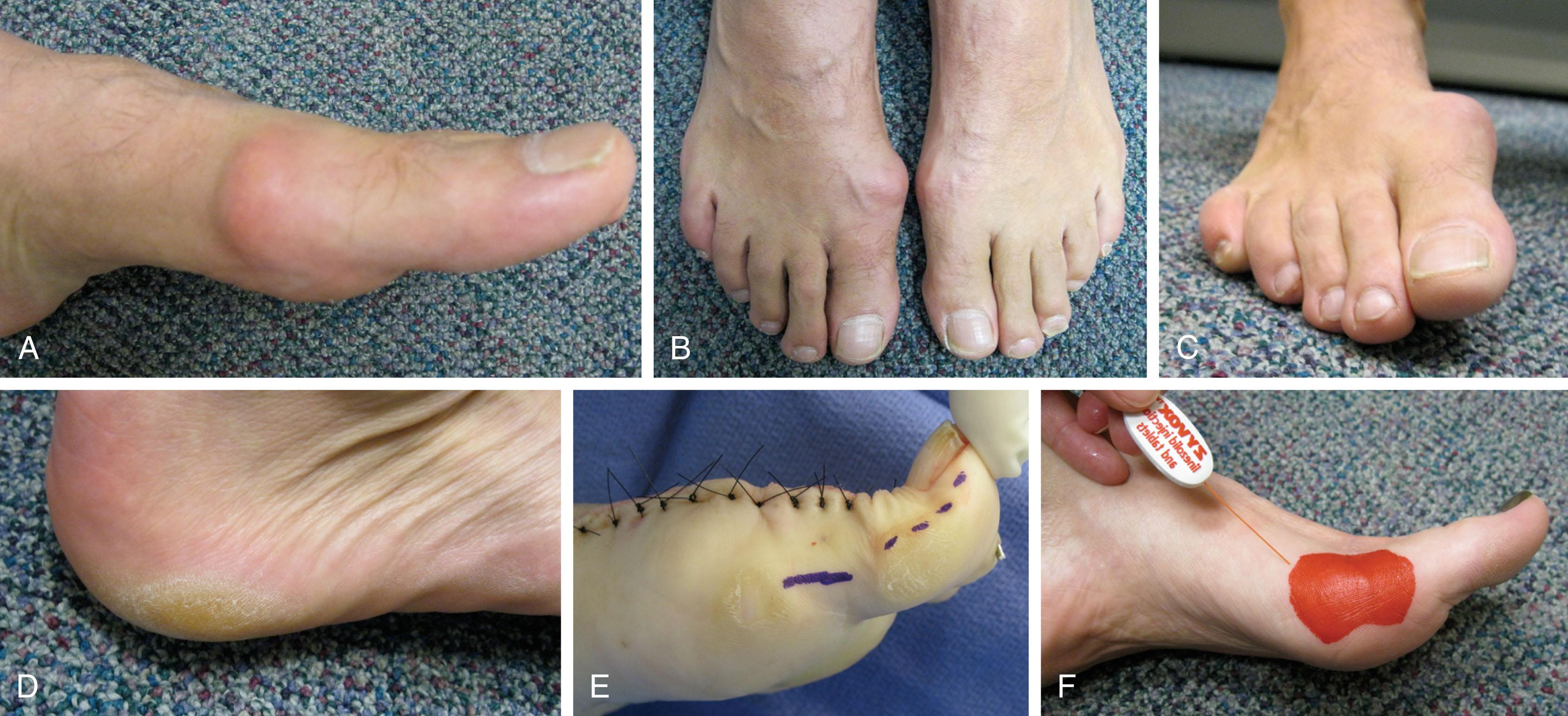
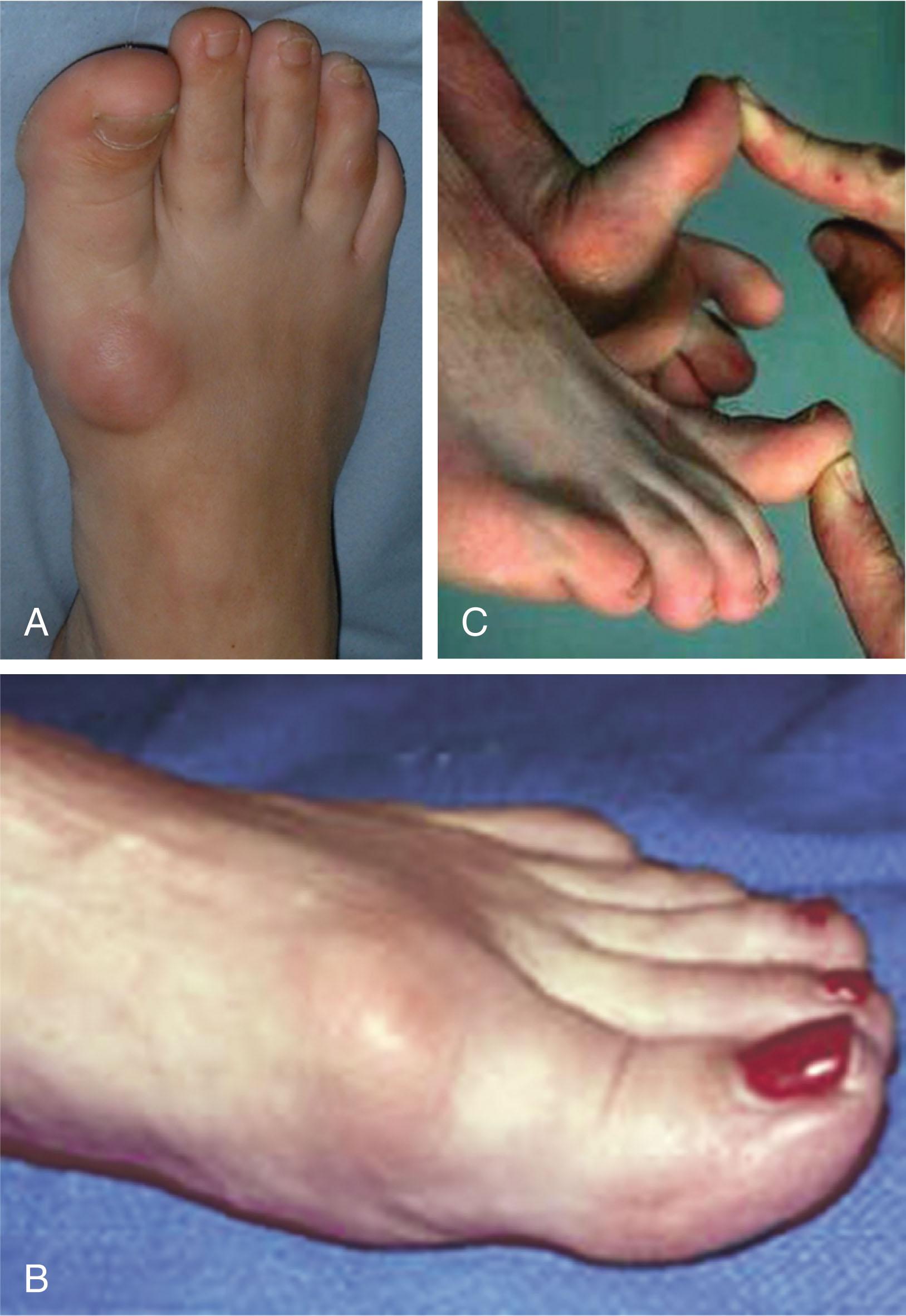
On forced dorsiflexion, pain often is elicited with bone impingement between the base of the proximal phalanx and dorsal metatarsal osteophytes. On forced plantar flexion, pain may be elicited from stretching of the extensor hallucis longus (EHL), MTP joint capsule, and inflamed synovium over the dorsal osteophyte. With ambulation, the patient often directs weight bearing to the outer aspect of the foot to minimize dorsiflexion of the first MTP joint. Tingling, hyperesthesia, or a positive Tinel sign over the dorsal digital nerve in the first web space can occur from compression against the dorsolateral osteophyte.
Standing AP, lateral, and sesamoid radiographs are obtained to evaluate the foot with hallux rigidus ( Fig. 27-7 ). The AP radiograph often demonstrates nonuniform joint space narrowing with widening and flattening of the first metatarsal head ( Fig. 27-8 ). An oblique radiograph can demonstrate an adequate joint space, which is obscured on the AP radiograph by overlying osteophytes. Subchondral cysts and sclerosis in the first metatarsal head, widening of the base of the proximal phalanx, and hypertrophy of the sesamoids can develop in more advanced stages.
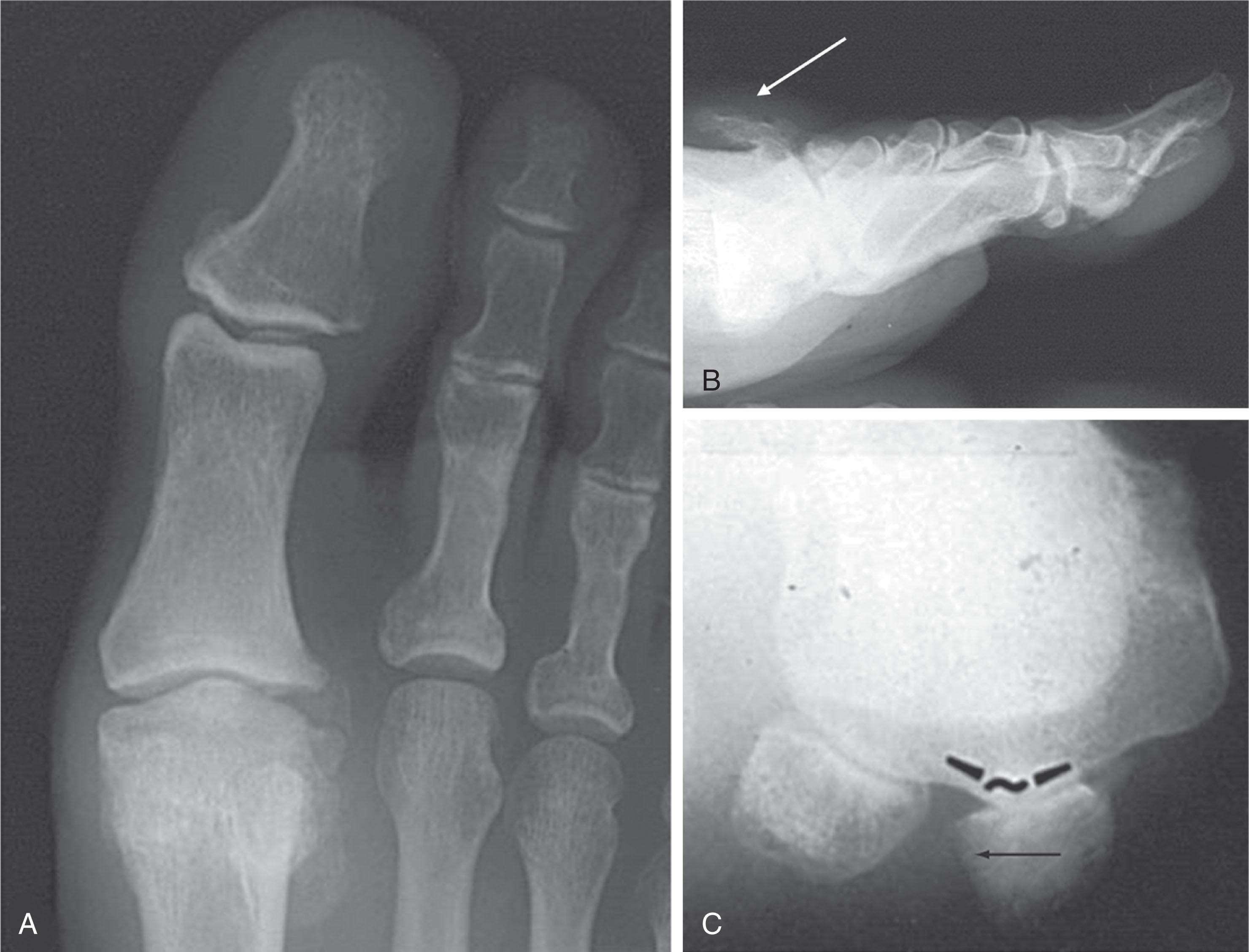
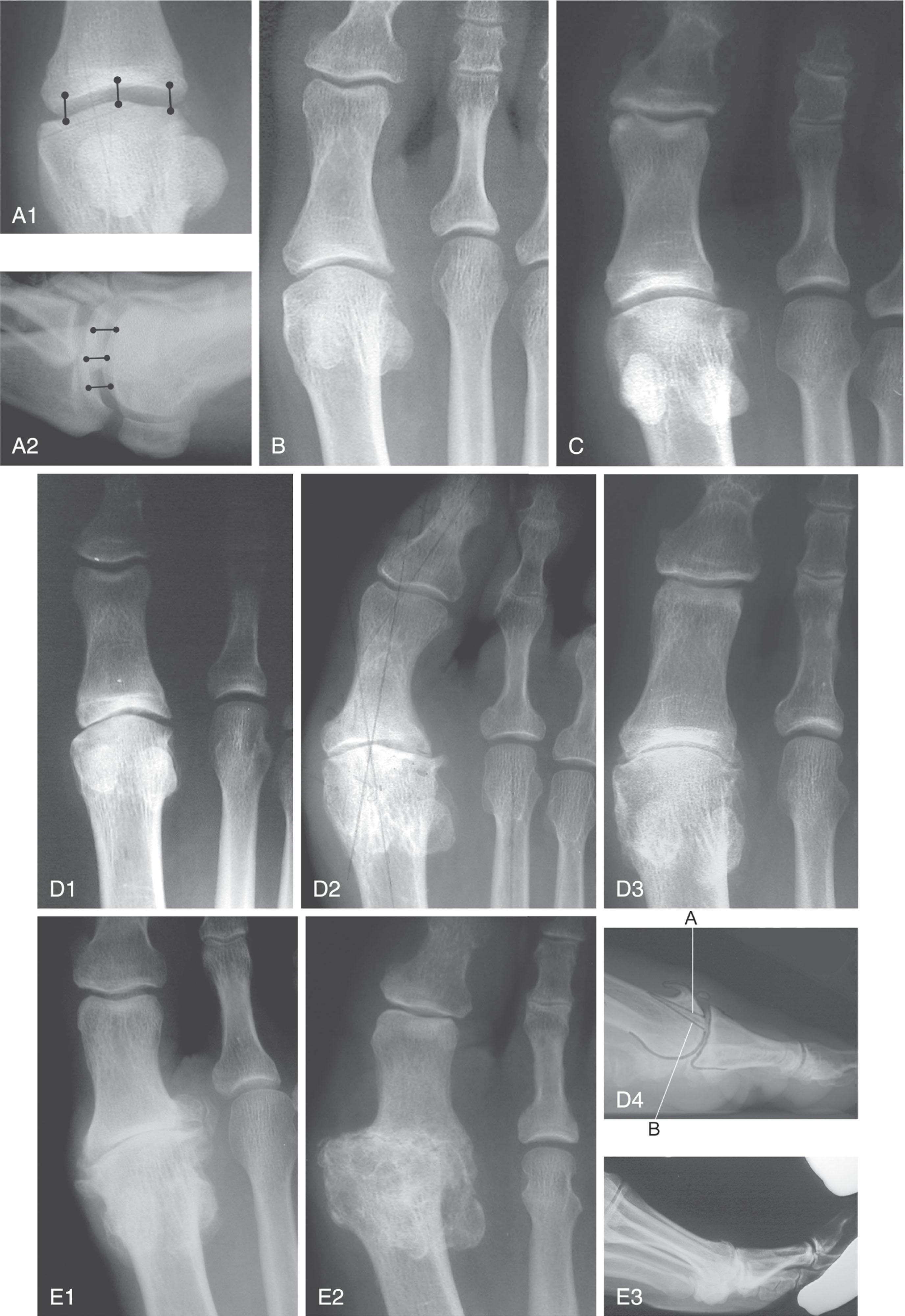
Osteophyte formation on the AP radiographs occurs more often on the lateral than the medial aspect of the metatarsal head. An osteochondral defect may be visualized in the central metatarsal articular surface area (see Figs. 27-2 and 27-8 ). On the lateral radiograph, in advanced cases, the dorsal metatarsal osteophyte can resemble dripping candle wax ( Fig. 27-7B ) as the osteophyte courses proximally along the dorsal first metatarsal metaphyseal shaft. Dorsophalangeal osteophytes and loose bodies may be present, and on a dorsiflexion stress view dorsal impingement may be observed and confirms that extension is blocked.
Lateral weight-bearing radiographs are also used to evaluate the presence of an elevated first metatarsal in relationship to the lesser metatarsals. With a true lateral radiograph, the central diaphyseal axes of the first and second metatarsals are marked. Meyer et al noted that in normal feet, up to 5 mm of elevation is normal ( Fig. 27-9 ).
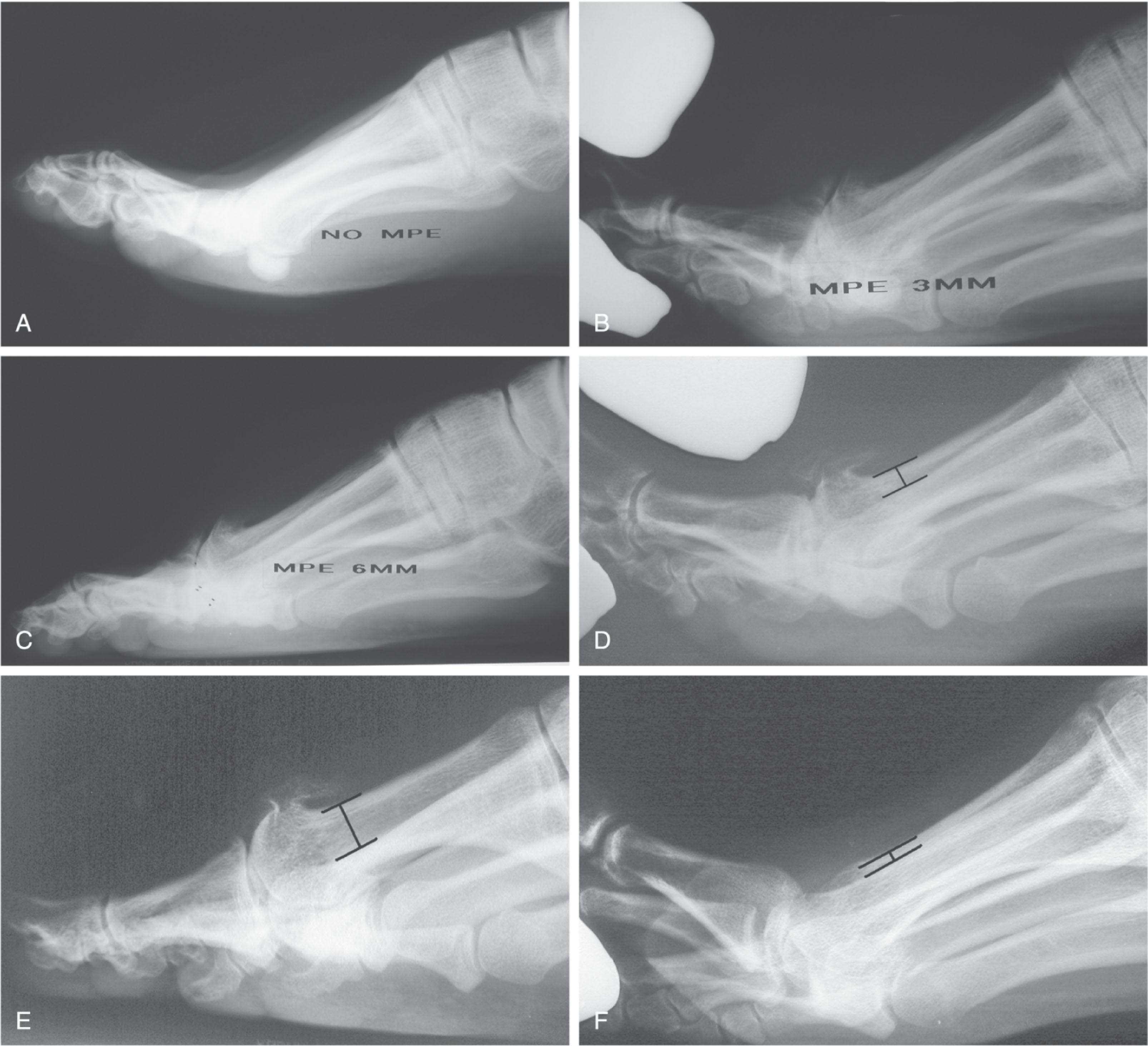
Evaluation of the metatarsal–sesamoid articulation with axial radiographs is important, although involvement of the sesamoid complex occurs infrequently except with severe arthroses (see Fig. 27-7C ).
Several different attempts have been made to classify hallux rigidus. A classification scheme is helpful in standardizing terminology both for describing the magnitude of the arthritic process and for recommending treatment. Table 27-1 outlines the recommended clinical and radiographic classification of hallux rigidus based on long-term evaluation and follow-up.
| Grade | Range of Motion | Radiograph | Clinical |
|---|---|---|---|
| 0 | Dorsiflexion 40–60 degrees and/or 10%–20% loss compared to normal side | Normal or minimal findings | No subjective pain, only stiffness; loss of passive motion on examination |
| 1 | Dorsiflexion 30–40 degrees and/or 20%–50% loss compared with normal side | Dorsal spur is main finding, minimal joint narrowing, minimal periarticular sclerosis, minimal flattening of metatarsal head | Mild or occasional subjective pain and stiffness; pain at extremes of dorsiflexion and/or plantar flexion on exam |
| 2 | Dorsiflexion 10–30 degrees and/or 50%–75% loss compared with normal side | Dorsal, lateral, and possibly medial osteophytes give flattened appearance to metatarsal head, no more than 25% dorsal joint space involvement on lateral radiograph, mild-to-moderate joint narrowing and sclerosis, sesamoids not usually involved but may be irregular in appearance | Moderate-to-severe subjective pain and stiffness that may be constant; pain just before maximal dorsiflexion and/or plantar flexion on examination |
| 3 | Dorsiflexion of 10 degrees or less and/or 75%–100% loss compared with normal side and notable loss of plantar flexion (often 10 degrees or less plantar flexion) | As in grade 2 but with substantial narrowing, possibly periarticular cystic changes, more than 25% dorsal joint may be involved on lateral side, sesamoids are enlarged and/or cystic and/or irregular | Nearly constant subjective pain and substantial stiffness; pain throughout range of motion on examination (but not at midrange) |
| 4 | Dorsiflexion of 10 degrees or less and/or 75%–100% loss compared with normal side and notable loss of plantar flexion (often 10 degrees or less plantar flexion) | As in grade 2 but with substantial narrowing, possibly periarticular cystic changes, more than 25% dorsal joint may be involved on lateral, sesamoids are enlarged and/or cystic and/or irregular | Nearly constant subjective pain and substantial stiffness; pain throughout range of motion on examination plus definite pain at midrange of motion |
Conservative management of hallux rigidus depends on a patient’s symptoms and the magnitude of the degenerative process. Early disease (characterized by synovial irritation) is treated with NSAIDs and a stiff insole to reduce excursion of the MTP joint ( Fig. 27-10 ). Several commercially available orthoses provide rigidity to the forepart of the shoe. Orthoses have been shown to provide greater and longer-term pain relief than NSAIDs alone ( Fig. 27-11 ).

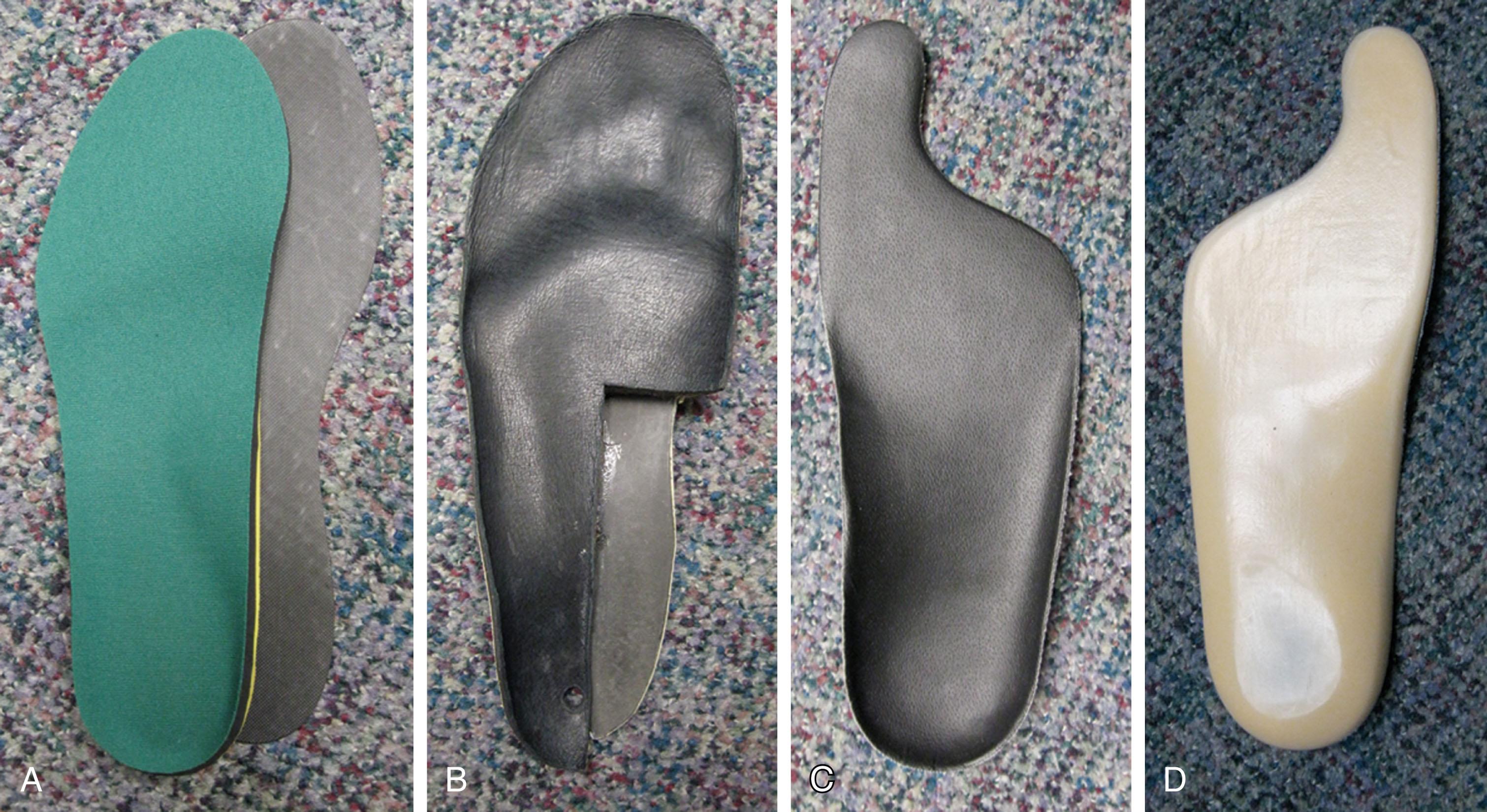
An insole with a Morton extension can also reduce MTP range of motion and can be moved from shoe to shoe. The addition of an extended steel or fiberglass shank between the inner and outer sole may be effective in reducing MTP motion. Prefabricated and custom-made orthoses can reduce midfoot pronation, which can reduce symptoms. Unfortunately, many orthoses decrease available room in the toe box, which can increase pressure on the dorsal exostosis. A shoe with a low heel and roomy upper can accommodate the enlarged MTP joint associated with a more advanced hallux rigidus deformity. Taping of the hallux ( Fig. 27-12 ) to decrease dorsiflexion excursion may be effective as well. Symptoms often subside if the first MTP joint is protected.
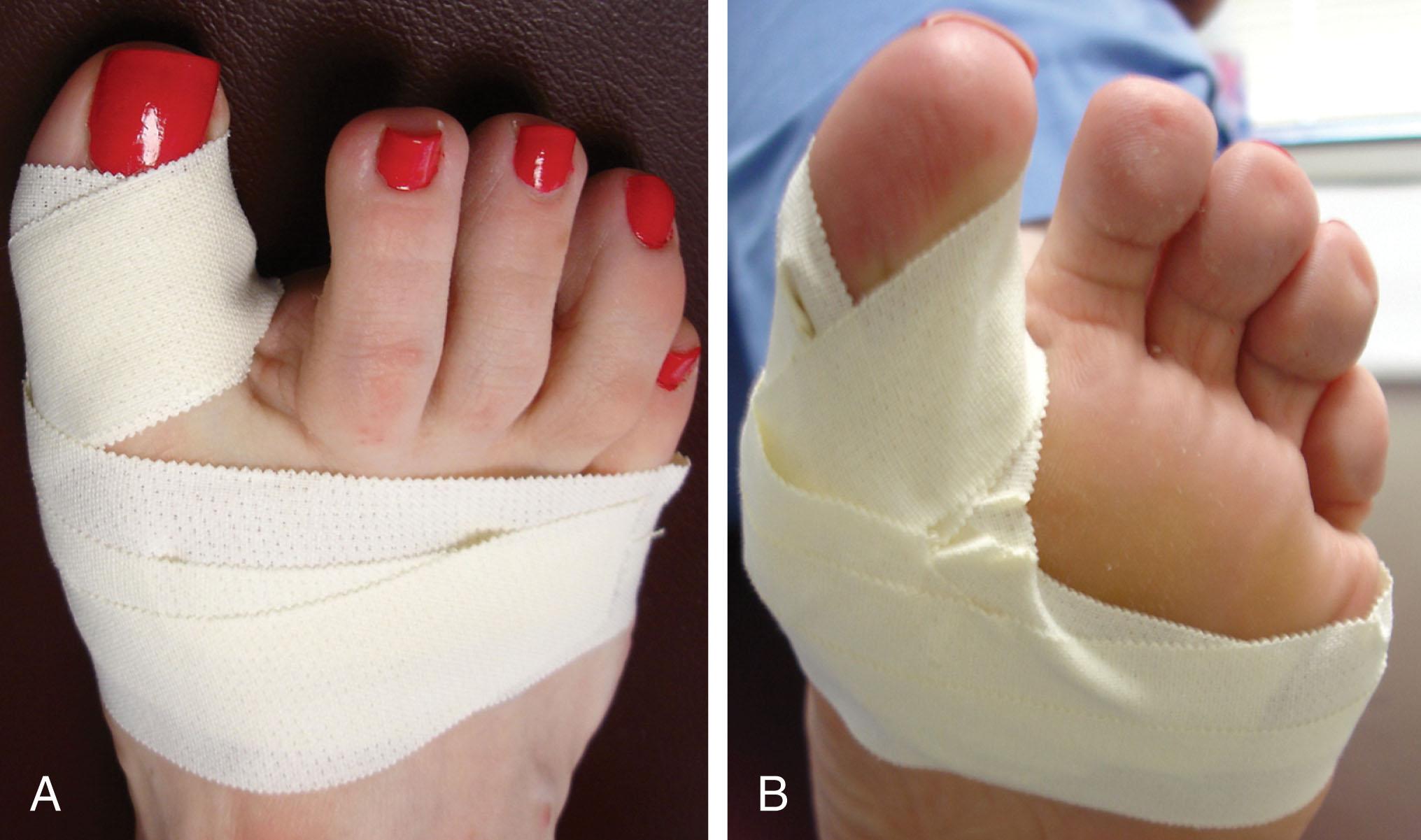
On occasion, the judicious use of an intraarticular steroid injection provides temporary relief. Repeated injections can accelerate the degenerative process and should be administered appropriately. When symptoms restrict activity, surgical intervention may be considered.
The results of nonoperative treatment have been evaluated. Solan et al noted approximately 6 months of benefit using intraarticular steroid injection and joint manipulation for mild-to-moderate hallux rigidus but found limited benefit for its use in more advanced grades of disease. Pons et al reported on the use of intraarticular sodium hyaluronate in a comparison with intraarticular corticosteroid injections in the treatment of painful hallux rigidus. Pain decreased significantly in both treatment groups. However, the effect was transitory, and at 1-year follow-up, a high percentage of patients in both groups had eventually required surgery.
Smith et al reported the long-term results of 22 patients (24 feet), with a mean follow-up of 14 years, who were treated nonoperatively for hallux rigidus. The authors found that 75% of patients still chose not to have surgery. The intensity of pain remained similar in 22 feet, improved with time in one, and worsened in one. Most patients were able to minimize pain by wearing a roomy, stiff-soled shoe. Others have reported successful treatment in nearly 60% of patients treated nonoperatively with footwear modifications, orthoses, injections, and taping. Follow-up ranged from 1 to 7 years (see Fig. 27-10 ).
The geriatric patient deserves special consideration because the mortality rate in patients older than 90 years who undergo elective surgery has been reported to be 2.3%. Age alone is not the sole determinant of whether elective procedures should be considered, but the severity of diseases and comorbidities are good predictors of surgical outcome. Cardiovascular complications account for nearly 50% of mortality. With the increase in the aging population, many geriatric patients benefit from elective operative management when indicated, but they should be counseled about the increased risks.
Decision making in the surgical treatment of hallux rigidus has traditionally been based on the degree of arthrosis present clinically and radiographically ( Fig. 27-13 ). In the presence of synovial thickening without radiographic demonstration of degenerative arthritis, an MTP joint synovectomy is the treatment of choice. Moreover, synovitis and limited MTP joint motion without radiographic changes should be evaluated by ruling out an inflammatory or potentially erosive joint process (complete blood count [CBC], ESR, CRP, ANA, RF, HLA-B27, and uric acid) or considering the possibility of other causes of joint restriction. Michelson and Dunn reported flexor hallucis stenosing tenosynovitis indicated by retromalleolar or arch tenderness over the flexor hallucis longus (FHL) and increased signal on MRI as a cause of hallux limitus in patients without radiographic changes in the first MTP joint but with restricted passive joint motion.

With an osteochondral defect of the first MTP joint, removal of cartilaginous loose fragments and drilling of the osseous base can aid in the regeneration of a fibrocartilaginous surface (see Fig. 27-2C and D ). In a younger patient, an osteochondral autogenous transfer procedure can be considered either in the first or lesser MTP joints for articular surface defects. Title et al reported a case using a combined cheilectomy and osteochondral transfer as treatment for the remaining cartilaginous defect. Hopson et al has also reported the use of an osteocartilaginous transfer for salvage of a failed first metatarsal head resurfacing implant.
In a juvenile or adult patient with restricted passive dorsiflexion but no significant dorsal exostosis (without clinical findings of flexor hallucis stenosis), a dorsal closing-wedge phalangeal osteotomy may improve joint function.
In an adult patient with impingement of the proximal phalanx against a dorsal osteophyte on the metatarsal head, a cheilectomy is the preferred treatment. If an unsatisfactory result occurs, other opportunities for salvage remain. Cheilectomy is the mainstay of surgical treatment for hallux rigidus and can be combined with other procedures tailored to a specific problem, such as an osteochondral autograft transfer system (OATS) procedure for a large central defect or microfracture for smaller defects, phalangeal osteotomy for severe interphalangeus or to enhance dorsiflexion, or soft tissue interposition for end-stage hallux rigidus in a patient who is opposed to an arthrodesis ( Fig. 27-14 ).
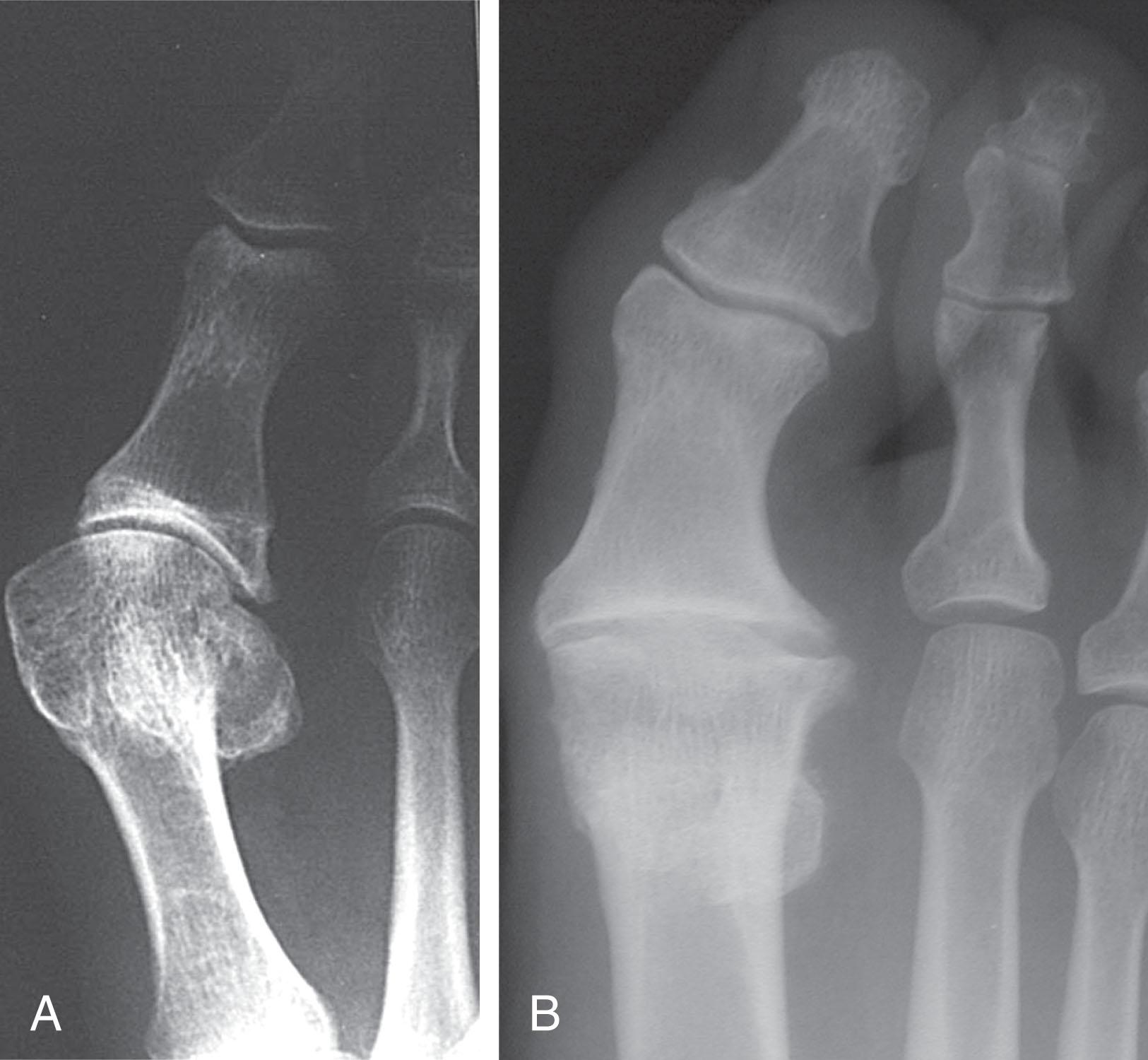
Typically, with grade 0 or 1 hallux rigidus, careful examination for FHL stenosing tenosynovitis is performed. If FHL stenosing tenosynovitis is diagnosed, then an FHL release is performed, and an MTP joint synovectomy or phalangeal osteotomy may be added depending on the individual case. In grade 2 or 3 hallux rigidus, a cheilectomy or, occasionally, a cheilectomy combined with a phalangeal osteotomy, may be considered, although reported success rates after phalangeal osteotomy are variable; Waizy et al reported improved MTP joint motion, whereas Kilmartin and Thomas reported little or no increase in motion after a dorsal closing-wedge phalangeal nti-infl. With grade 4 hallux rigidus (severe degenerative arthritis), salvage procedures include arthrodesis, excisional arthroplasty, soft tissue interpositional arthroplasty, or prosthetic replacement.
Preoperative planning includes careful inspection of the preoperative AP and, especially, the lateral radiograph for loss of joint space. A careful physical examination is performed to assess pain with gentle loading of the hallux in a neutral position with respect to dorsiflexion and plantar flexion. If this maneuver elicits pain at the midrange of motion, the remaining cartilage surface is inadequate and portends a poor prognosis for the success of cheilectomy.
To establish, in general, a painfree MTP joint, an arthrodesis, interposition arthroplasty, or joint resection arthroplasty may be necessary. The authors do not advocate a Keller resection arthroplasty; rather, if an arthrodesis is not an acceptable alternative to the patient, a soft tissue interposition arthroplasty as described by Coughlin or Hamilton is recommended.
Although many activities are possible after an arthrodesis, many younger patients often prefer to preserve motion. Procedures to reestablish motion at the MTP joint often do so at the expense of stability. Resection arthroplasty has been favored for hallux rigidus, but not in the younger patient. Often, with an excisional arthroplasty, weakness of plantar flexion at the MTP joint occurs and can lead to transfer metatarsalgia. In an older, less active patient, a resection arthroplasty or resection arthroplasty with interposition of soft tissue may be considered.
For patients who want moderate physical activity, resection arthroplasty should be discouraged. However, less destructive resection arthroplasties, such as the Valenti procedure (resection of the dorsal proximal phalanx and metatarsal head in a V-shaped cut), have reported a high proportion of good and excellent results (33 of 36 procedures) in younger patients (mean age, 50.6 years) with a mean follow-up of 4.2 years. Implant arthroplasty has been advocated for treatment of hallux rigidus, but reported complications and severe difficulty with revision procedures have made this procedure less popular (see later discussion of implants for the first MTP joint).
The implantation of a synthetic cartilage in the form of a polyvinyl hydrogel has gained much attention, and early studies showed promising results. Baumhauer et al., in a prospective randomized multicenter study, compared the Cartiva implant to first MTP arthrodeses and noted equivalent pain relief, equivalent functional outcomes, and a 27.2% increase in range of motion at 2 years.
Not only did it require less surgical time, but it resulted in a shorter recovery time than did arthrodesis. A 5-year follow-up demonstrated no evidence of implant wear or loosening.
A dorsal closing-wedge proximal phalangeal osteotomy was initially proposed by Bonney and Macnab for the treatment of adolescents with hallux rigidus. Kessel and Bonney reported on the results of this technique. Heaney, Harrison, and later Moberg recommended phalangeal osteotomy to use available plantar flexion and create a “functional transfer of plantar flexion to dorsiflexion” with this osteotomy.
The indications for a dorsal closing-wedge proximal phalangeal osteotomy for hallux rigidus are in the adolescent patient with no significant osteophyte formation. This may be used in combination with an FHL release when indicated and less often in combination with cheilectomy in the skeletally mature patient.
The technique is as follows.
A medial longitudinal incision extending from the interphalangeal joint to a point 1 cm proximal to the first MTP joint exposes the proximal phalanx.
The MTP joint is identified. A dorsal closing-wedge osteotomy is performed just distal to the MTP joint space. In the adolescent patient, care must be taken to avoid injury to an open proximal phalangeal epiphysis. The size of the resected wedge is determined by the degree of plantar flexion at the MTP joint. This osteotomy should permit the toe to be dorsiflexed to 35 degrees in relationship to the metatarsal shaft (15 degrees in relationship to the plantar surface of the foot) ( Fig. 27-15A ).
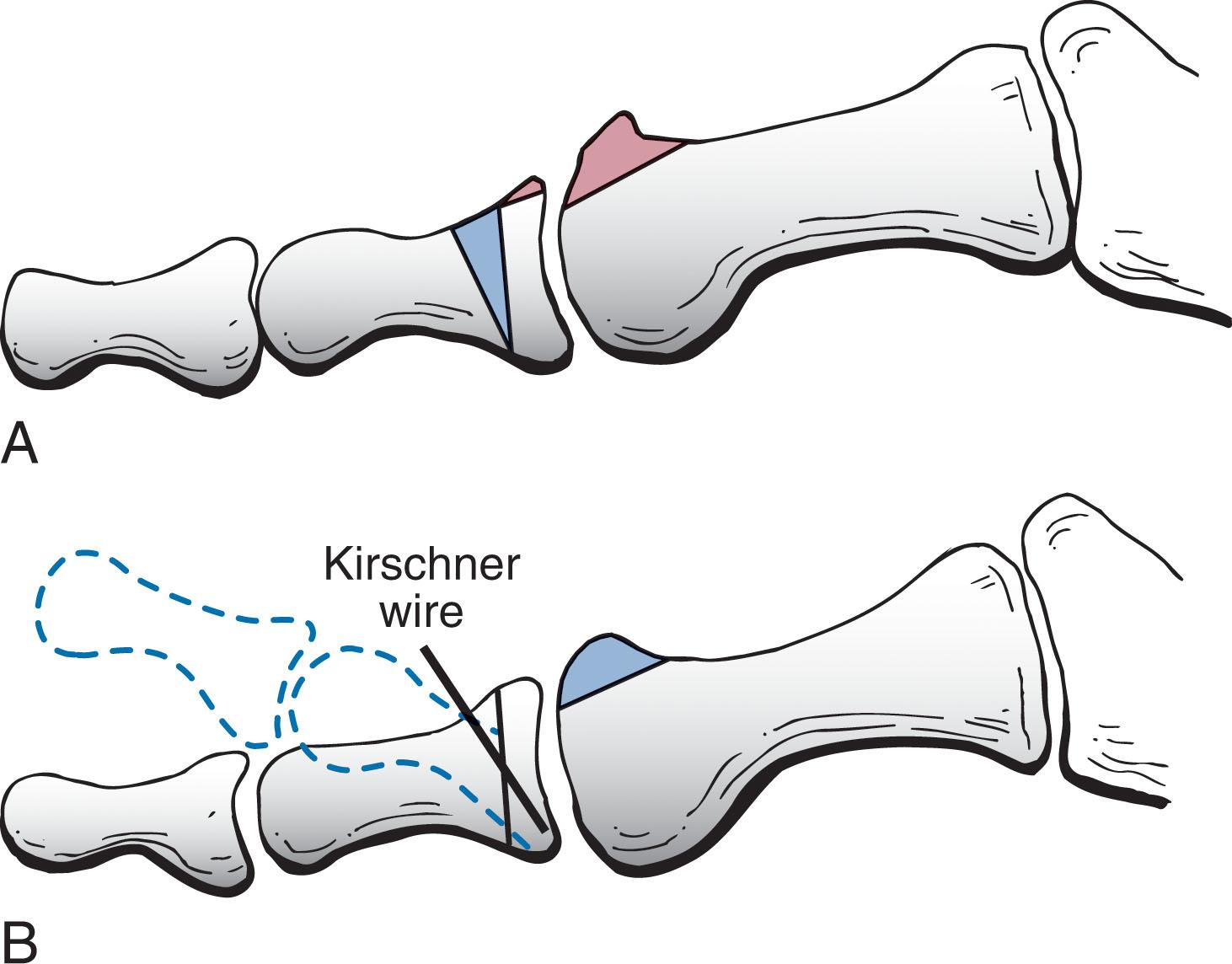
The osteotomy is firmly secured with crossed or parallel K-wires, screws, compression staples, or sutures placed through drill holes at the osteotomy site ( Fig. 27-15B ). If a phalangeal osteotomy is combined with a cheilectomy, stable internal fixation is mandatory because early motion is necessary for a successful cheilectomy. The wound is closed in a routine manner.
A gauze-and-tape compression dressing is applied at surgery and changed weekly. The patient is allowed to ambulate in a postoperative shoe. Dressing changes and guarded ambulation are necessary until the osteotomy site is healed 4 to 6 weeks after surgery. Internal fixation is removed when necessary after successful healing is demonstrated.
The indications for phalangeal osteotomy in relationship to hallux rigidus remain to be clearly delineated.
For an adolescent with hallux rigidus, a phalangeal osteotomy appears to be advantageous, but the osteotomy must avoid an open phalangeal physis when present. In an adolescent, a cheilectomy might not be necessary because there is rarely significant arthrosis or osteophyte formation; however, inspection of the metatarsal articular surface is important because an osteochondral defect should be treated. Kessell and Bonney reported on nine adolescents with short-term follow-up (average, 14 months), noting pain relief in more than 90% and an average increase in dorsiflexion of 39 degrees.
Although this procedure was originally recommended for adolescent patients, Moberg extended the indications to the adult population. For an adult with grade 1 hallux rigidus, a phalangeal osteotomy may be sufficient treatment. With significant MTP arthrosis, an isolated phalangeal osteotomy might not be sufficient treatment and occasionally may be combined with a cheilectomy for grades 2 and 3 disease. A short-term follow-up of 12 months, Maes and colleagues noted that a combined Moberg-Akin proximal phalanx osteotomy with cheilectomy can yield good results with all grades of hallux rigidus. In a long-term follow-up of phalangeal osteotomies (average follow-up, 11 years), Citron reported that 50% of patients had complete relief of pain, although further degenerative arthrosis was noted. Waizy et al reported midterm and long-term follow-up on 60 patients who underwent a cheilectomy and phalangeal osteotomy and suggested that for substantial arthritis, the phalangeal osteotomy likely improved satisfaction.
Although the osteotomy may improve the static position of the hallux, marked increased dorsiflexion range of motion is rarely achieved. Kilmartin, in a report on 49 patients who underwent a phalangeal osteotomy and cheilectomy, reported only 65% satisfaction and a loss of 1 degree of dorsiflexion at more than 1-year follow-up. Thomas and Smith reported on 17 patients who underwent a combination cheilectomy and phalangeal osteotomy for grades 1 and 2 hallux rigidus. All osteotomies healed. Although the average increase in dorsiflexion was only 7 degrees, 96% of patients were satisfied with their surgical result. With only a cheilectomy, early motion may be aggressively pursued; with a cheilectomy and phalangeal osteotomy, pain or cautious implementation of range of motion activities (because of the osteotomy) may compromise the ultimate goal of an increase in dorsiflexion.
In a comparison of arthrodesis and proximal phalangeal osteotomy for hallux rigidus, Southgate and Urry reported similarly good results in terms of pain relief in 10 patients with osteotomies compared with 20 patients with arthrodeses, with a mean of 12 years of follow-up. Whether the studies of Thomas and Smith and Southgate and Urry will be confirmed with greater numbers of longer-term positive results remains to be determined.
Cheilectomy, or excision of the dorsal exostosis of the metatarsal head, was first proposed by Nilsonne, who attempted the procedure in two cases but thought it offered only temporary relief. Bonney and Macnab later used this technique for cases of “polyarthritis” and noted poor results. In 1959, DuVries advocated removal of the proliferative bone at the MTP joint to enable dorsiflexion. Although he noted 90% satisfactory results, no long-term follow-up was reported. In 1979, Mann et al described their technique of cheilectomy and reported successful results at long-term follow-up. Later, Coughlin and Shurnas reported 92% successful results using Mann’s technique of cheilectomy in 80 patients, with more than 9 years of follow-up. This study clearly defined the role of cheilectomy in treating all grades of hallux rigidus and proposed a clinical and radiographic classification to help select appropriate surgical treatment (see Table 27-1 and Fig. 27-10 ).
Although some have stressed the temporary nature of the procedure or limited indications, the current authors perform cheilectomy for grades 1 and 2 hallux rigidus, in younger athletic patients, and in patients with more advanced degenerative arthrosis (grade 3 hallux rigidus with more than 50% of the metatarsal articular surface remaining) who wish to avoid the risk and morbidity of a more extensive procedure. Geldwert et al and others have demonstrated that, for grades 1 and 2 hallux rigidus (using a different classification scheme), a cheilectomy relieved pain significantly in 93% of patients, but for grade 3 hallux rigidus, the success rate fell to 29%. A cheilectomy is a simple procedure that leaves a stable joint, has low morbidity, and preserves strength and joint motion.
The technique is as follows.
A dorsal longitudinal incision extends from the middle of the proximal phalanx to 3 cm proximal to the MTP joint. The extensor hood and joint capsule are incised, and the dissection is deepened on the medial or lateral aspect of the EHL tendon ( Fig. 27-16A ).
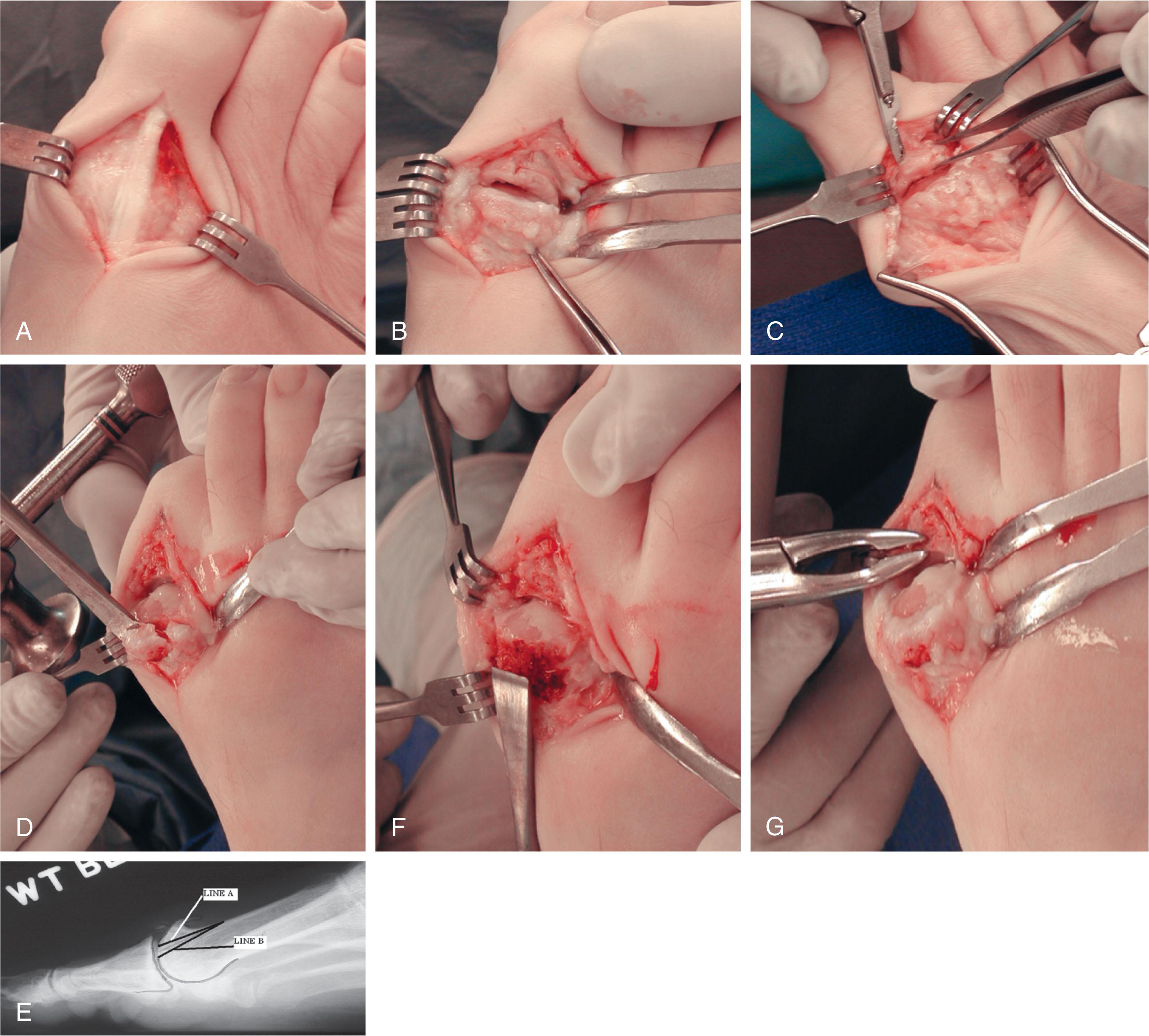
A thorough synovectomy is carried out, and the MTP joint is inspected to locate osteophytes or loose bodies and to assess the extent of the articular cartilage damage ( Fig. 27-16B ). The proximal phalanx is plantar flexed to aid in exposure, and any dorsal phalangeal osteophyte is resected ( Fig. 27-16C and H ).
The joint is inspected to determine the amount and location of cartilage loss ( Fig. 27-16D ). If a cheilectomy is indicated (more than 50% of metatarsal articular cartilage is viable), then the metatarsal osteophyte is generously resected on the dorsal, dorsomedial, and dorsolateral aspects using a 6-mm osteotome ( Fig. 27-16E ). It is critical that at least 20% to 30% of the dorsal metatarsal head is removed with this oblique osteotomy. The decision regarding the extent of bone resection depends on the size of the dorsal exostosis, the amount of articular cartilage destruction, and the need to establish adequate dorsiflexion at the conclusion of the procedure.
The resection is initiated just dorsal to the edge of the remaining viable metatarsal articular cartilage. (Thus, with more severe arthrosis, more metatarsal head is resected.) However, more extensive resection can increase the risk of MTP subluxation, and greater than 30% to 40% resection is discouraged. Any remaining eburnated bone or defects can be microfractured or drilled, and if less than 50% of the metatarsal articular surface is viable, an arthrodesis is recommended.
Any articular cartilage irregularities are removed, including loose cartilaginous fragments. Dorsiflexion of approximately 60 degrees is desirable after an extensive cheilectomy. Any dorsal or medial osteophytes are removed from the base of the proximal phalanx and along the upper border of the metatarsal head.
The raw bone surfaces are smoothed with a rasp or rongeur. The joint capsule is closed in a routine manner. A gauze-and-tape compression dressing is applied and changed weekly.
Become a Clinical Tree membership for Full access and enjoy Unlimited articles
If you are a member. Log in here